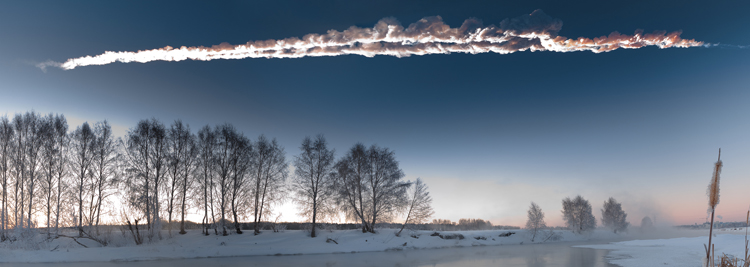Current Events Lesson Plan: February 25-March 2, 2016
Current Event: If a Meteor Falls to Earth But No One Is There to Hear It, Does It Make a Sound?
On February 6, a large fireball exploded over the Atlantic Ocean, some 600 miles (970 kilometers) off the coast of Brazil. Had it disintegrated over a populated area, it could have caused many injuries and deaths. The February 6 fireball was the largest to reach Earth since the Chelyabinsk meteor exploded over southeastern Russia almost exactly three years earlier. That fireball was recorded on video by dozens of people, giving scientists and the public alike a detailed view of the strike. The shockwave from the explosion damaged thousands of buildings and injured over 1,500 people, mostly with flying glass from broken windows. Scientists think the Chelyabinsk meteor was about 65 feet (20 meters) across and weighed more than 11,000 tons (10,000 metric tons). Scientists are studying meteor strikes to detect potential meteoroids that could threaten major population centers on Earth, and are investigating ways to destroy or alter the paths of would-be meteors.

This photograph shows the Chelyabinsk meteor streaking through the sky above Chelyabinsk, Russia, on Feb. 15, 2013. The small asteroid was about 56 to 66 feet (17 to 20 meters) wide. Credit: M. Ahmetvaleev/NASA/JPL-Caltech
Objective:
Meteors are streaks of light that appear in the sky. The brightest meteors are known as fireballs or bolides. A meteor appears when a piece of matter enters Earth’s atmosphere from space at high speed. Such a piece of matter is called a meteoroid. Most meteoroids that cause visible meteors are smaller than a pebble. As the meteoroid collides with the air, it is heated so that it glows, creating a shining trail of hot gases. Most meteoroids break apart in a second or less. Meteorites are meteoroids that reach Earth’s surface intact. Most large meteorites come from asteroids, which typically consist of stronger material than that of comets. Such material is less likely to break up during descent. If a meteoroid travels too fast, as was the case with the Chelyabinsk meteor, it may explode before reaching Earth’s surface. The Behind the Headlines news story and related World Book articles explore meteors and other astronomical topics.
Words to know:
Discussion Topics:
1. A meteoroid is a celestial object that orbits the sun. Ask your students if they know any other types of celestial objects that orbit the sun. (They might say the eight planets; five recognized dwarf planets, including Pluto; comets, such as Halley’s Comet; asteroids.)
2. Ask your students what they know about Brazil. (Students might say that it is the largest country in South America in terms of both area and population; Rio de Janeiro and São Paulo are the country’s two largest cities, and Brasília is its capital; about two-thirds of the Amazon rain forest is in the country; the country is the world’s largest coffee producer.)
3. Have your students debate the topic, “Should countries invest money in a weapon that could destroy any meteoroid that might hit Earth.”
4. Ask your students to use the World Book’s Timelines feature to create a timeline of important astronomical discoveries. (Your students may wish to use the “History” section of World Book’s Astronomy article to help them make their timeline.)


